Influence of incentives to the management on carbon emissions in the USA
VerifiedAdded on 2023/06/07
|12
|2862
|211
AI Summary
This research project aims to evaluate the impact of incentives on carbon emissions in the USA, with a focus on stakeholder theory. The conceptual model includes dependent and independent variables, control variables, and proxy measures. The data collection is secondary in nature, and the data analysis includes descriptive statistics and trend analysis. The study concludes that the level of carbon emission is more volatile in 2013 compared to 2012.
Contribute Materials
Your contribution can guide someone’s learning journey. Share your
documents today.

MGT723 Research Project
Assessment Task 2: Data Collection
Student Name: Tajul Islam Rabby
Title: Influence of incentives to the management on carbon emissions in the USA
Submission Date: week 8
Assessment Task 2: Data Collection
Student Name: Tajul Islam Rabby
Title: Influence of incentives to the management on carbon emissions in the USA
Submission Date: week 8
Secure Best Marks with AI Grader
Need help grading? Try our AI Grader for instant feedback on your assignments.
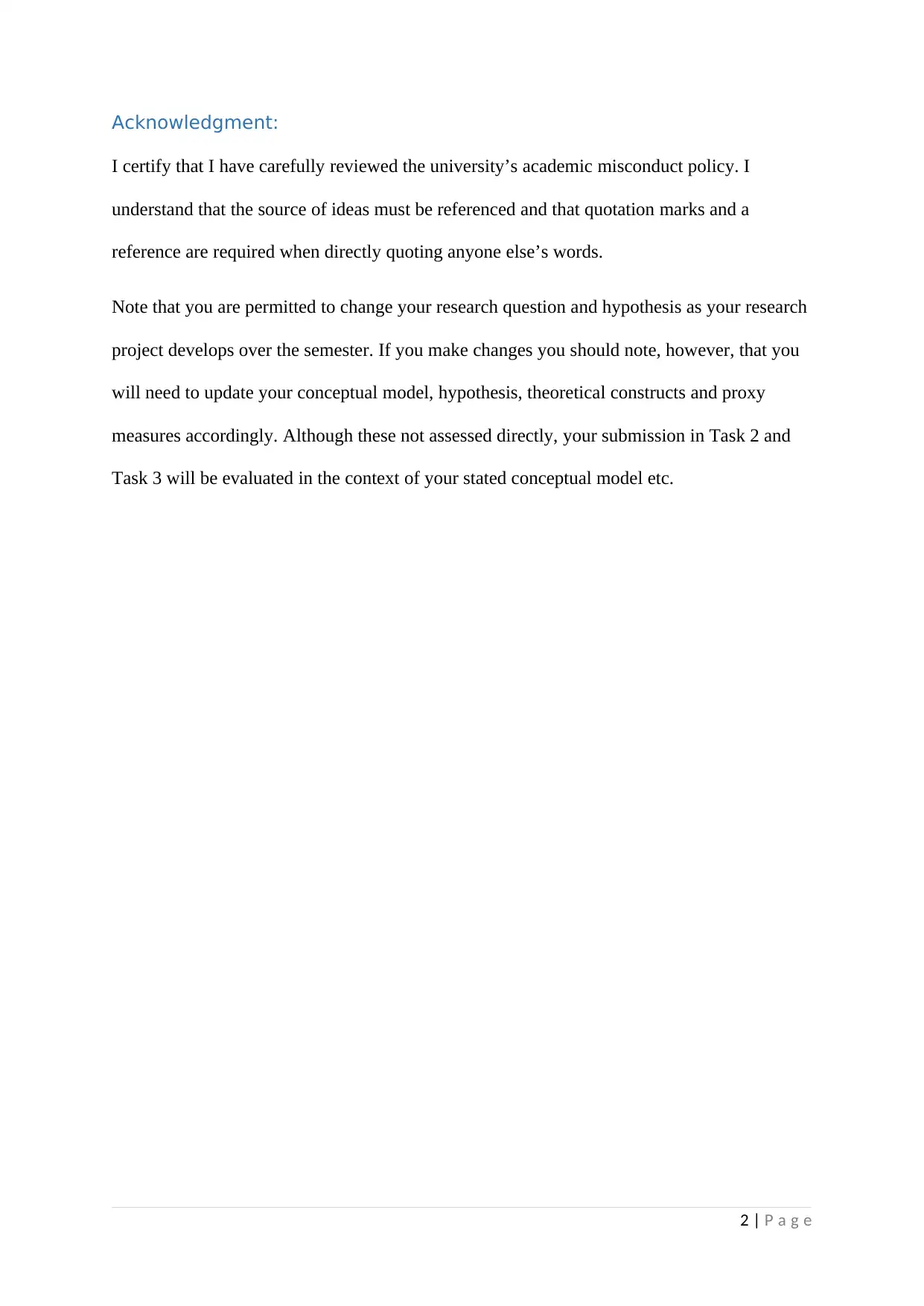
Acknowledgment:
I certify that I have carefully reviewed the university’s academic misconduct policy. I
understand that the source of ideas must be referenced and that quotation marks and a
reference are required when directly quoting anyone else’s words.
Note that you are permitted to change your research question and hypothesis as your research
project develops over the semester. If you make changes you should note, however, that you
will need to update your conceptual model, hypothesis, theoretical constructs and proxy
measures accordingly. Although these not assessed directly, your submission in Task 2 and
Task 3 will be evaluated in the context of your stated conceptual model etc.
2 | P a g e
I certify that I have carefully reviewed the university’s academic misconduct policy. I
understand that the source of ideas must be referenced and that quotation marks and a
reference are required when directly quoting anyone else’s words.
Note that you are permitted to change your research question and hypothesis as your research
project develops over the semester. If you make changes you should note, however, that you
will need to update your conceptual model, hypothesis, theoretical constructs and proxy
measures accordingly. Although these not assessed directly, your submission in Task 2 and
Task 3 will be evaluated in the context of your stated conceptual model etc.
2 | P a g e
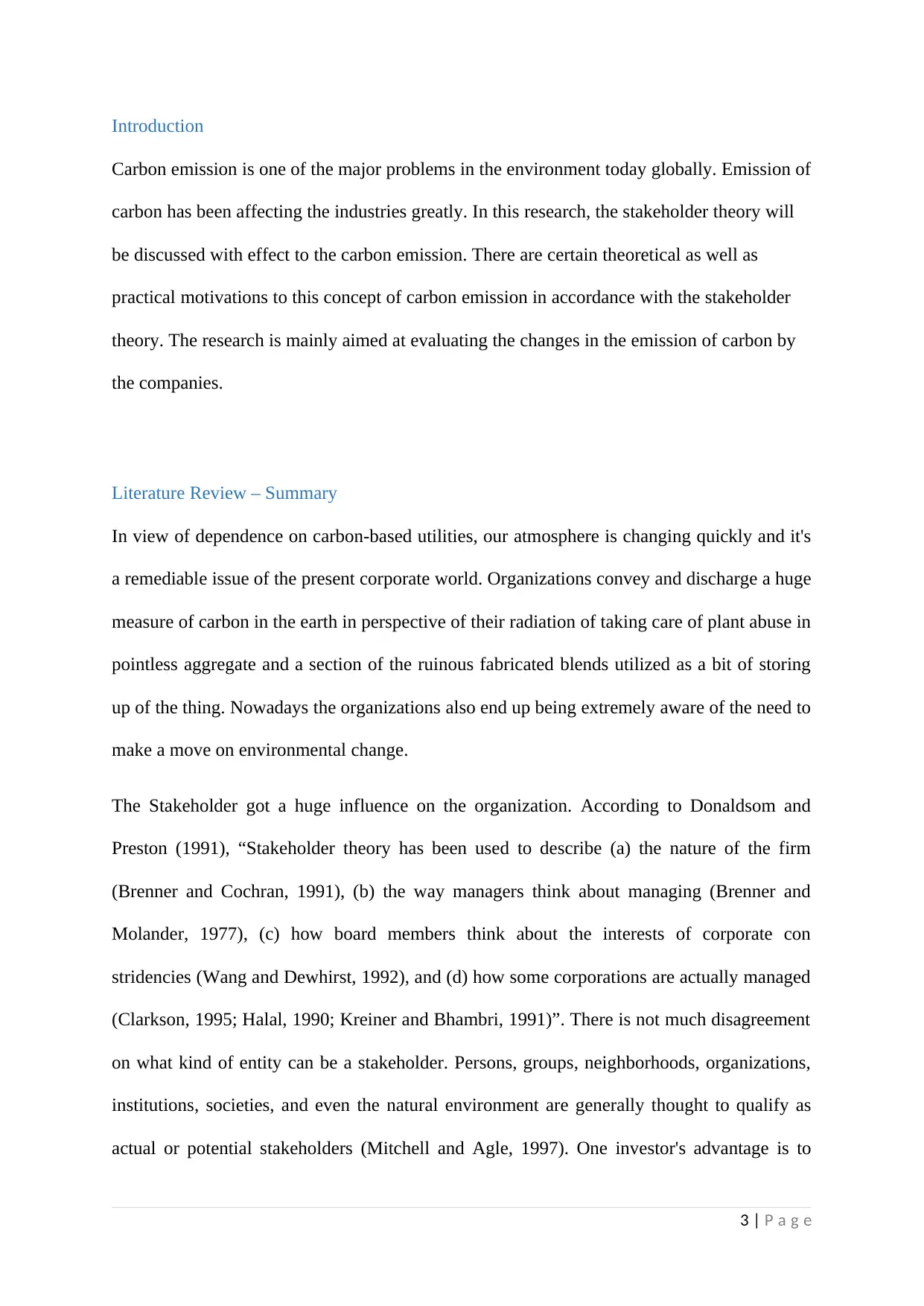
Introduction
Carbon emission is one of the major problems in the environment today globally. Emission of
carbon has been affecting the industries greatly. In this research, the stakeholder theory will
be discussed with effect to the carbon emission. There are certain theoretical as well as
practical motivations to this concept of carbon emission in accordance with the stakeholder
theory. The research is mainly aimed at evaluating the changes in the emission of carbon by
the companies.
Literature Review – Summary
In view of dependence on carbon-based utilities, our atmosphere is changing quickly and it's
a remediable issue of the present corporate world. Organizations convey and discharge a huge
measure of carbon in the earth in perspective of their radiation of taking care of plant abuse in
pointless aggregate and a section of the ruinous fabricated blends utilized as a bit of storing
up of the thing. Nowadays the organizations also end up being extremely aware of the need to
make a move on environmental change.
The Stakeholder got a huge influence on the organization. According to Donaldsom and
Preston (1991), “Stakeholder theory has been used to describe (a) the nature of the firm
(Brenner and Cochran, 1991), (b) the way managers think about managing (Brenner and
Molander, 1977), (c) how board members think about the interests of corporate con
stridencies (Wang and Dewhirst, 1992), and (d) how some corporations are actually managed
(Clarkson, 1995; Halal, 1990; Kreiner and Bhambri, 1991)”. There is not much disagreement
on what kind of entity can be a stakeholder. Persons, groups, neighborhoods, organizations,
institutions, societies, and even the natural environment are generally thought to qualify as
actual or potential stakeholders (Mitchell and Agle, 1997). One investor's advantage is to
3 | P a g e
Carbon emission is one of the major problems in the environment today globally. Emission of
carbon has been affecting the industries greatly. In this research, the stakeholder theory will
be discussed with effect to the carbon emission. There are certain theoretical as well as
practical motivations to this concept of carbon emission in accordance with the stakeholder
theory. The research is mainly aimed at evaluating the changes in the emission of carbon by
the companies.
Literature Review – Summary
In view of dependence on carbon-based utilities, our atmosphere is changing quickly and it's
a remediable issue of the present corporate world. Organizations convey and discharge a huge
measure of carbon in the earth in perspective of their radiation of taking care of plant abuse in
pointless aggregate and a section of the ruinous fabricated blends utilized as a bit of storing
up of the thing. Nowadays the organizations also end up being extremely aware of the need to
make a move on environmental change.
The Stakeholder got a huge influence on the organization. According to Donaldsom and
Preston (1991), “Stakeholder theory has been used to describe (a) the nature of the firm
(Brenner and Cochran, 1991), (b) the way managers think about managing (Brenner and
Molander, 1977), (c) how board members think about the interests of corporate con
stridencies (Wang and Dewhirst, 1992), and (d) how some corporations are actually managed
(Clarkson, 1995; Halal, 1990; Kreiner and Bhambri, 1991)”. There is not much disagreement
on what kind of entity can be a stakeholder. Persons, groups, neighborhoods, organizations,
institutions, societies, and even the natural environment are generally thought to qualify as
actual or potential stakeholders (Mitchell and Agle, 1997). One investor's advantage is to
3 | P a g e
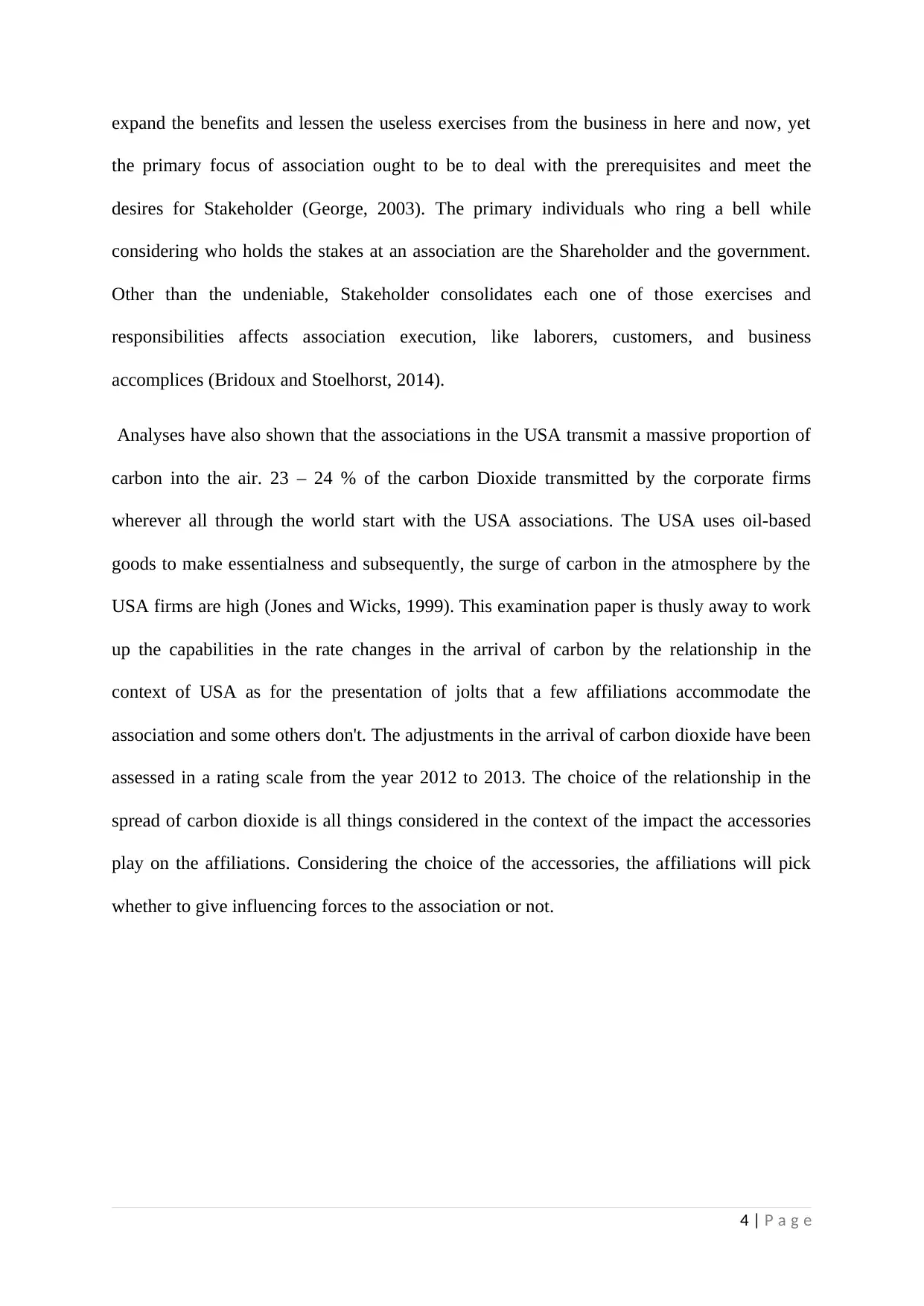
expand the benefits and lessen the useless exercises from the business in here and now, yet
the primary focus of association ought to be to deal with the prerequisites and meet the
desires for Stakeholder (George, 2003). The primary individuals who ring a bell while
considering who holds the stakes at an association are the Shareholder and the government.
Other than the undeniable, Stakeholder consolidates each one of those exercises and
responsibilities affects association execution, like laborers, customers, and business
accomplices (Bridoux and Stoelhorst, 2014).
Analyses have also shown that the associations in the USA transmit a massive proportion of
carbon into the air. 23 – 24 % of the carbon Dioxide transmitted by the corporate firms
wherever all through the world start with the USA associations. The USA uses oil-based
goods to make essentialness and subsequently, the surge of carbon in the atmosphere by the
USA firms are high (Jones and Wicks, 1999). This examination paper is thusly away to work
up the capabilities in the rate changes in the arrival of carbon by the relationship in the
context of USA as for the presentation of jolts that a few affiliations accommodate the
association and some others don't. The adjustments in the arrival of carbon dioxide have been
assessed in a rating scale from the year 2012 to 2013. The choice of the relationship in the
spread of carbon dioxide is all things considered in the context of the impact the accessories
play on the affiliations. Considering the choice of the accessories, the affiliations will pick
whether to give influencing forces to the association or not.
4 | P a g e
the primary focus of association ought to be to deal with the prerequisites and meet the
desires for Stakeholder (George, 2003). The primary individuals who ring a bell while
considering who holds the stakes at an association are the Shareholder and the government.
Other than the undeniable, Stakeholder consolidates each one of those exercises and
responsibilities affects association execution, like laborers, customers, and business
accomplices (Bridoux and Stoelhorst, 2014).
Analyses have also shown that the associations in the USA transmit a massive proportion of
carbon into the air. 23 – 24 % of the carbon Dioxide transmitted by the corporate firms
wherever all through the world start with the USA associations. The USA uses oil-based
goods to make essentialness and subsequently, the surge of carbon in the atmosphere by the
USA firms are high (Jones and Wicks, 1999). This examination paper is thusly away to work
up the capabilities in the rate changes in the arrival of carbon by the relationship in the
context of USA as for the presentation of jolts that a few affiliations accommodate the
association and some others don't. The adjustments in the arrival of carbon dioxide have been
assessed in a rating scale from the year 2012 to 2013. The choice of the relationship in the
spread of carbon dioxide is all things considered in the context of the impact the accessories
play on the affiliations. Considering the choice of the accessories, the affiliations will pick
whether to give influencing forces to the association or not.
4 | P a g e
Secure Best Marks with AI Grader
Need help grading? Try our AI Grader for instant feedback on your assignments.
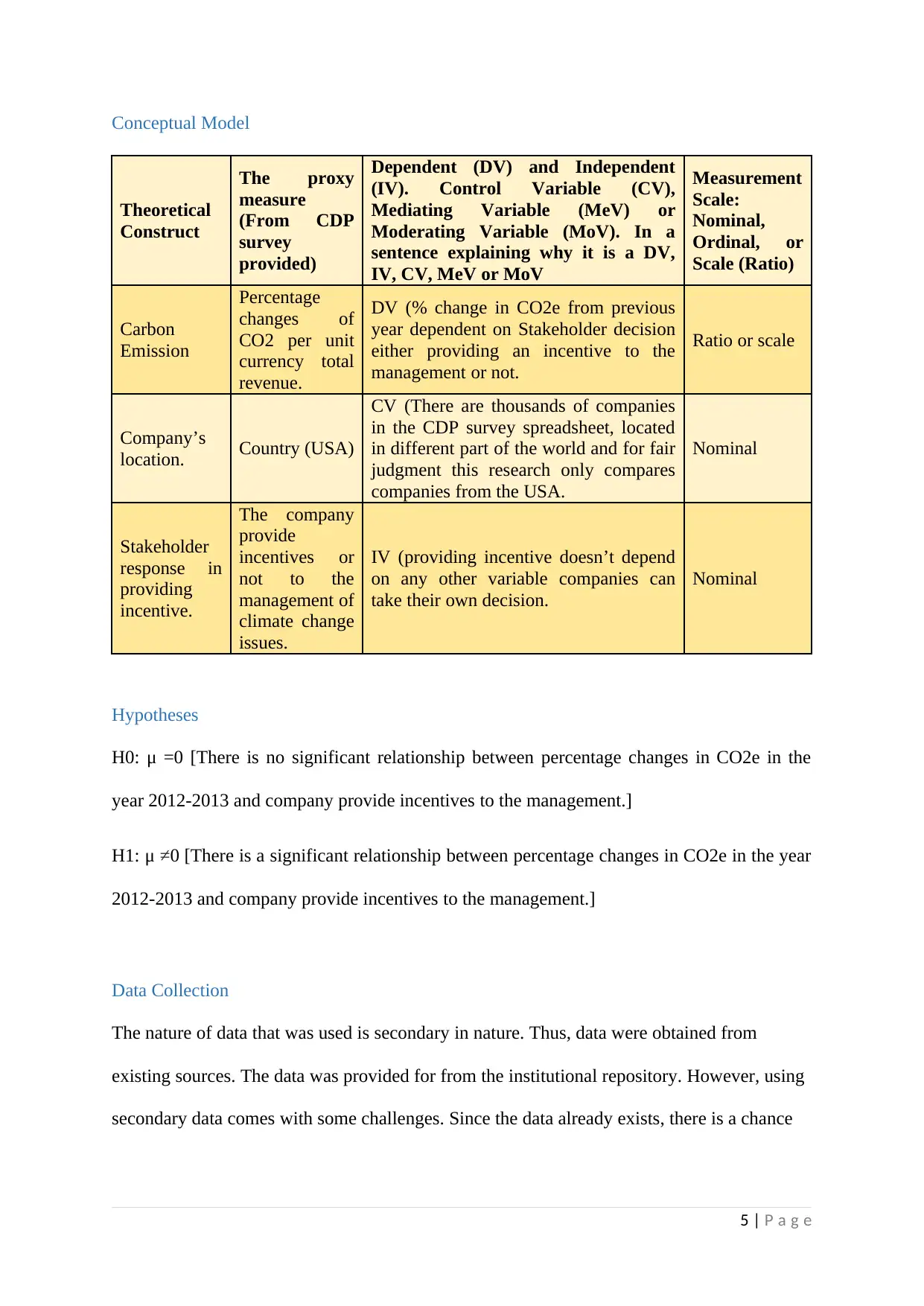
Conceptual Model
Theoretical
Construct
The proxy
measure
(From CDP
survey
provided)
Dependent (DV) and Independent
(IV). Control Variable (CV),
Mediating Variable (MeV) or
Moderating Variable (MoV). In a
sentence explaining why it is a DV,
IV, CV, MeV or MoV
Measurement
Scale:
Nominal,
Ordinal, or
Scale (Ratio)
Carbon
Emission
Percentage
changes of
CO2 per unit
currency total
revenue.
DV (% change in CO2e from previous
year dependent on Stakeholder decision
either providing an incentive to the
management or not.
Ratio or scale
Company’s
location. Country (USA)
CV (There are thousands of companies
in the CDP survey spreadsheet, located
in different part of the world and for fair
judgment this research only compares
companies from the USA.
Nominal
Stakeholder
response in
providing
incentive.
The company
provide
incentives or
not to the
management of
climate change
issues.
IV (providing incentive doesn’t depend
on any other variable companies can
take their own decision.
Nominal
Hypotheses
H0: μ =0 [There is no significant relationship between percentage changes in CO2e in the
year 2012-2013 and company provide incentives to the management.]
H1: μ ≠0 [There is a significant relationship between percentage changes in CO2e in the year
2012-2013 and company provide incentives to the management.]
Data Collection
The nature of data that was used is secondary in nature. Thus, data were obtained from
existing sources. The data was provided for from the institutional repository. However, using
secondary data comes with some challenges. Since the data already exists, there is a chance
5 | P a g e
Theoretical
Construct
The proxy
measure
(From CDP
survey
provided)
Dependent (DV) and Independent
(IV). Control Variable (CV),
Mediating Variable (MeV) or
Moderating Variable (MoV). In a
sentence explaining why it is a DV,
IV, CV, MeV or MoV
Measurement
Scale:
Nominal,
Ordinal, or
Scale (Ratio)
Carbon
Emission
Percentage
changes of
CO2 per unit
currency total
revenue.
DV (% change in CO2e from previous
year dependent on Stakeholder decision
either providing an incentive to the
management or not.
Ratio or scale
Company’s
location. Country (USA)
CV (There are thousands of companies
in the CDP survey spreadsheet, located
in different part of the world and for fair
judgment this research only compares
companies from the USA.
Nominal
Stakeholder
response in
providing
incentive.
The company
provide
incentives or
not to the
management of
climate change
issues.
IV (providing incentive doesn’t depend
on any other variable companies can
take their own decision.
Nominal
Hypotheses
H0: μ =0 [There is no significant relationship between percentage changes in CO2e in the
year 2012-2013 and company provide incentives to the management.]
H1: μ ≠0 [There is a significant relationship between percentage changes in CO2e in the year
2012-2013 and company provide incentives to the management.]
Data Collection
The nature of data that was used is secondary in nature. Thus, data were obtained from
existing sources. The data was provided for from the institutional repository. However, using
secondary data comes with some challenges. Since the data already exists, there is a chance
5 | P a g e
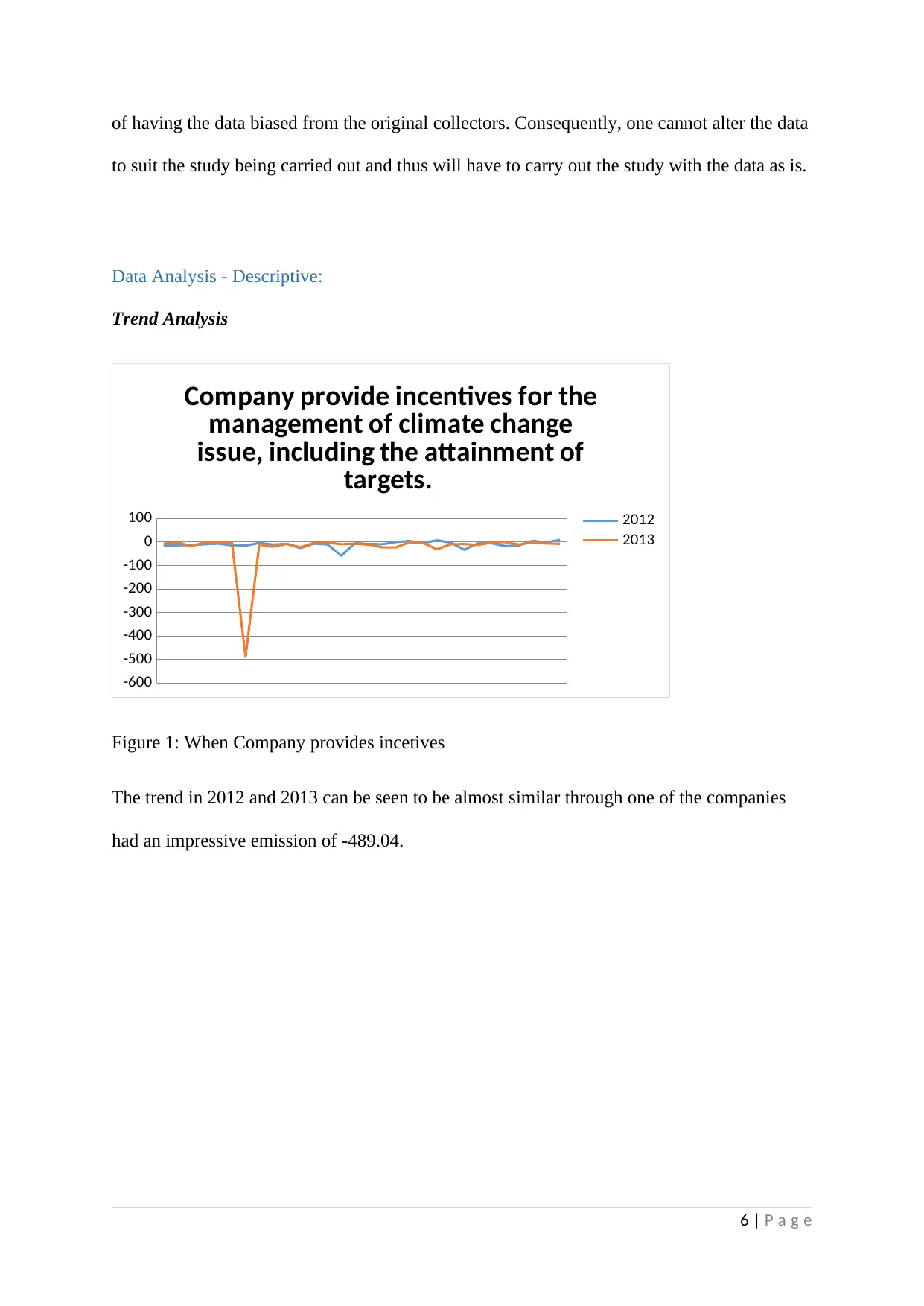
of having the data biased from the original collectors. Consequently, one cannot alter the data
to suit the study being carried out and thus will have to carry out the study with the data as is.
Data Analysis - Descriptive:
Trend Analysis
-600
-500
-400
-300
-200
-100
0
100
Company provide incentives for the
management of climate change
issue, including the attainment of
targets.
2012
2013
Figure 1: When Company provides incetives
The trend in 2012 and 2013 can be seen to be almost similar through one of the companies
had an impressive emission of -489.04.
6 | P a g e
to suit the study being carried out and thus will have to carry out the study with the data as is.
Data Analysis - Descriptive:
Trend Analysis
-600
-500
-400
-300
-200
-100
0
100
Company provide incentives for the
management of climate change
issue, including the attainment of
targets.
2012
2013
Figure 1: When Company provides incetives
The trend in 2012 and 2013 can be seen to be almost similar through one of the companies
had an impressive emission of -489.04.
6 | P a g e

-100
-80
-60
-40
-20
0
20
40
Company does not provide
incentives for the management of
climate change issue, including the
attainment of targets.
2012 2013
Figure 2: When Company does not provide incentives
Similarly, the trend for 2012 and 2013 are almost similar though there are marginal
differences.
The company provides incentives for the management
Table 1: Descriptive statistics when company provides incentives
2012 2013
Mean -10.03 -25.41
Median -8.50 -8.50
Mode -14 -1
Range 67.80 488.33
Variance 164.47 7731.80
Standard deviation 12.82 87.93
Interquartile range 9.75 10.48
quartile deviation 4.88 5.24
Skewness -2.01 -5.41
Kurtosis 6.72 29.45
From table 1 above, it is evident that the mean of carbon emission when the company
provides incentives for the management is -10.03 ± 12.82 in 2012 and -25.41 ± 87.93 in
2013. Thus, the mean of the level of carbon emission is higher in 2012 compared to 2013
when the company provides incentives to the management. However, the median of the level
7 | P a g e
-80
-60
-40
-20
0
20
40
Company does not provide
incentives for the management of
climate change issue, including the
attainment of targets.
2012 2013
Figure 2: When Company does not provide incentives
Similarly, the trend for 2012 and 2013 are almost similar though there are marginal
differences.
The company provides incentives for the management
Table 1: Descriptive statistics when company provides incentives
2012 2013
Mean -10.03 -25.41
Median -8.50 -8.50
Mode -14 -1
Range 67.80 488.33
Variance 164.47 7731.80
Standard deviation 12.82 87.93
Interquartile range 9.75 10.48
quartile deviation 4.88 5.24
Skewness -2.01 -5.41
Kurtosis 6.72 29.45
From table 1 above, it is evident that the mean of carbon emission when the company
provides incentives for the management is -10.03 ± 12.82 in 2012 and -25.41 ± 87.93 in
2013. Thus, the mean of the level of carbon emission is higher in 2012 compared to 2013
when the company provides incentives to the management. However, the median of the level
7 | P a g e
Paraphrase This Document
Need a fresh take? Get an instant paraphrase of this document with our AI Paraphraser
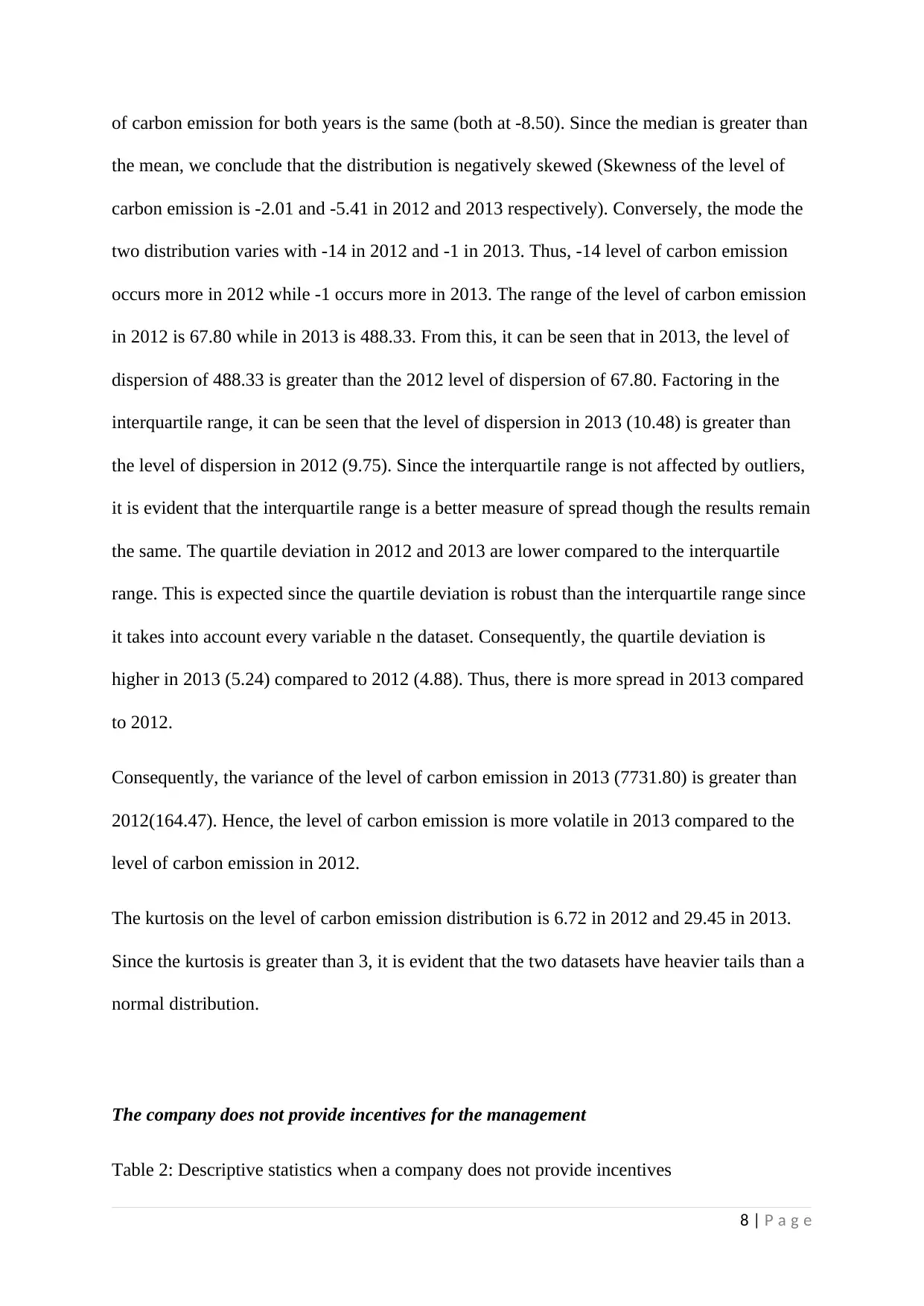
of carbon emission for both years is the same (both at -8.50). Since the median is greater than
the mean, we conclude that the distribution is negatively skewed (Skewness of the level of
carbon emission is -2.01 and -5.41 in 2012 and 2013 respectively). Conversely, the mode the
two distribution varies with -14 in 2012 and -1 in 2013. Thus, -14 level of carbon emission
occurs more in 2012 while -1 occurs more in 2013. The range of the level of carbon emission
in 2012 is 67.80 while in 2013 is 488.33. From this, it can be seen that in 2013, the level of
dispersion of 488.33 is greater than the 2012 level of dispersion of 67.80. Factoring in the
interquartile range, it can be seen that the level of dispersion in 2013 (10.48) is greater than
the level of dispersion in 2012 (9.75). Since the interquartile range is not affected by outliers,
it is evident that the interquartile range is a better measure of spread though the results remain
the same. The quartile deviation in 2012 and 2013 are lower compared to the interquartile
range. This is expected since the quartile deviation is robust than the interquartile range since
it takes into account every variable n the dataset. Consequently, the quartile deviation is
higher in 2013 (5.24) compared to 2012 (4.88). Thus, there is more spread in 2013 compared
to 2012.
Consequently, the variance of the level of carbon emission in 2013 (7731.80) is greater than
2012(164.47). Hence, the level of carbon emission is more volatile in 2013 compared to the
level of carbon emission in 2012.
The kurtosis on the level of carbon emission distribution is 6.72 in 2012 and 29.45 in 2013.
Since the kurtosis is greater than 3, it is evident that the two datasets have heavier tails than a
normal distribution.
The company does not provide incentives for the management
Table 2: Descriptive statistics when a company does not provide incentives
8 | P a g e
the mean, we conclude that the distribution is negatively skewed (Skewness of the level of
carbon emission is -2.01 and -5.41 in 2012 and 2013 respectively). Conversely, the mode the
two distribution varies with -14 in 2012 and -1 in 2013. Thus, -14 level of carbon emission
occurs more in 2012 while -1 occurs more in 2013. The range of the level of carbon emission
in 2012 is 67.80 while in 2013 is 488.33. From this, it can be seen that in 2013, the level of
dispersion of 488.33 is greater than the 2012 level of dispersion of 67.80. Factoring in the
interquartile range, it can be seen that the level of dispersion in 2013 (10.48) is greater than
the level of dispersion in 2012 (9.75). Since the interquartile range is not affected by outliers,
it is evident that the interquartile range is a better measure of spread though the results remain
the same. The quartile deviation in 2012 and 2013 are lower compared to the interquartile
range. This is expected since the quartile deviation is robust than the interquartile range since
it takes into account every variable n the dataset. Consequently, the quartile deviation is
higher in 2013 (5.24) compared to 2012 (4.88). Thus, there is more spread in 2013 compared
to 2012.
Consequently, the variance of the level of carbon emission in 2013 (7731.80) is greater than
2012(164.47). Hence, the level of carbon emission is more volatile in 2013 compared to the
level of carbon emission in 2012.
The kurtosis on the level of carbon emission distribution is 6.72 in 2012 and 29.45 in 2013.
Since the kurtosis is greater than 3, it is evident that the two datasets have heavier tails than a
normal distribution.
The company does not provide incentives for the management
Table 2: Descriptive statistics when a company does not provide incentives
8 | P a g e
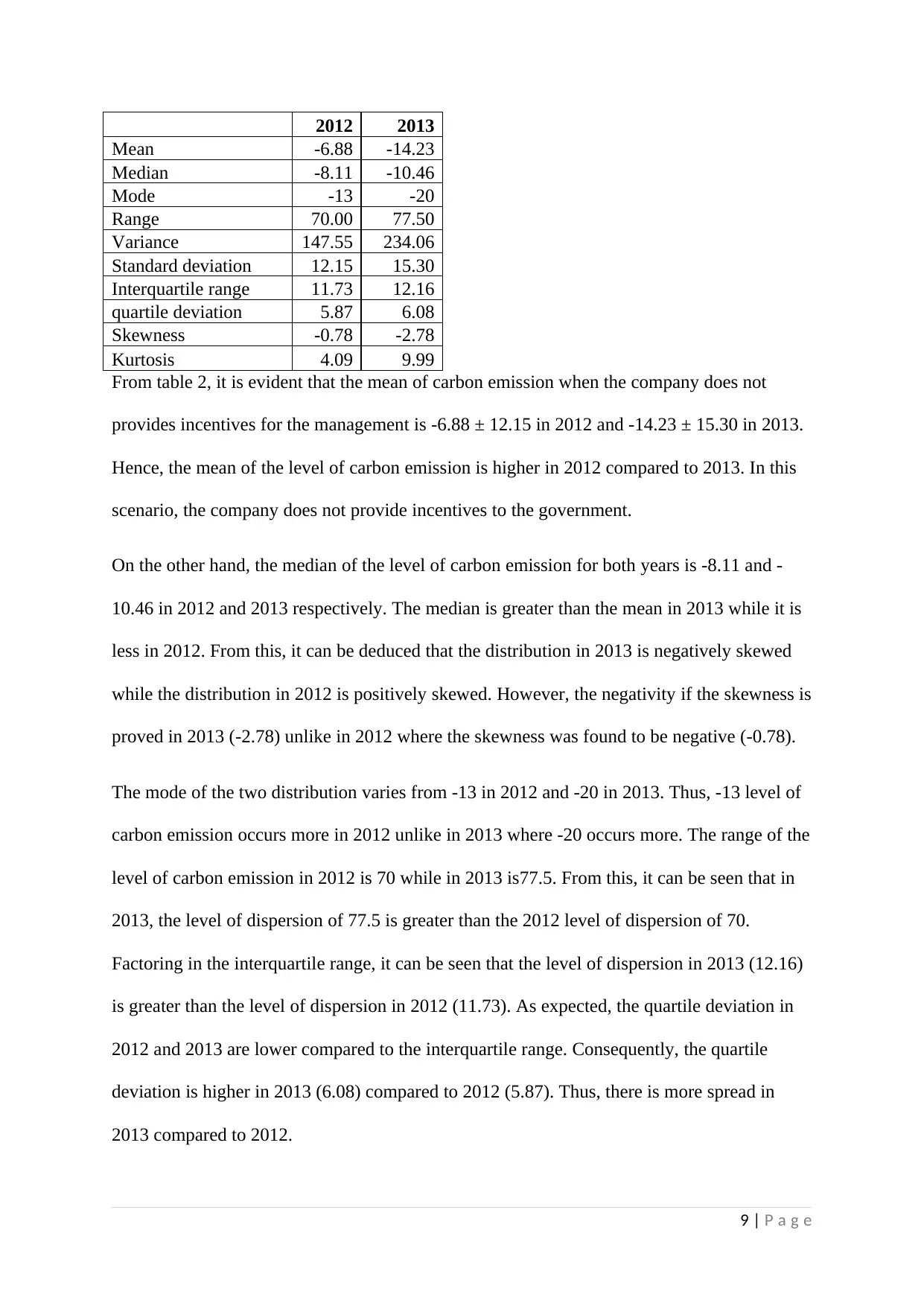
2012 2013
Mean -6.88 -14.23
Median -8.11 -10.46
Mode -13 -20
Range 70.00 77.50
Variance 147.55 234.06
Standard deviation 12.15 15.30
Interquartile range 11.73 12.16
quartile deviation 5.87 6.08
Skewness -0.78 -2.78
Kurtosis 4.09 9.99
From table 2, it is evident that the mean of carbon emission when the company does not
provides incentives for the management is -6.88 ± 12.15 in 2012 and -14.23 ± 15.30 in 2013.
Hence, the mean of the level of carbon emission is higher in 2012 compared to 2013. In this
scenario, the company does not provide incentives to the government.
On the other hand, the median of the level of carbon emission for both years is -8.11 and -
10.46 in 2012 and 2013 respectively. The median is greater than the mean in 2013 while it is
less in 2012. From this, it can be deduced that the distribution in 2013 is negatively skewed
while the distribution in 2012 is positively skewed. However, the negativity if the skewness is
proved in 2013 (-2.78) unlike in 2012 where the skewness was found to be negative (-0.78).
The mode of the two distribution varies from -13 in 2012 and -20 in 2013. Thus, -13 level of
carbon emission occurs more in 2012 unlike in 2013 where -20 occurs more. The range of the
level of carbon emission in 2012 is 70 while in 2013 is77.5. From this, it can be seen that in
2013, the level of dispersion of 77.5 is greater than the 2012 level of dispersion of 70.
Factoring in the interquartile range, it can be seen that the level of dispersion in 2013 (12.16)
is greater than the level of dispersion in 2012 (11.73). As expected, the quartile deviation in
2012 and 2013 are lower compared to the interquartile range. Consequently, the quartile
deviation is higher in 2013 (6.08) compared to 2012 (5.87). Thus, there is more spread in
2013 compared to 2012.
9 | P a g e
Mean -6.88 -14.23
Median -8.11 -10.46
Mode -13 -20
Range 70.00 77.50
Variance 147.55 234.06
Standard deviation 12.15 15.30
Interquartile range 11.73 12.16
quartile deviation 5.87 6.08
Skewness -0.78 -2.78
Kurtosis 4.09 9.99
From table 2, it is evident that the mean of carbon emission when the company does not
provides incentives for the management is -6.88 ± 12.15 in 2012 and -14.23 ± 15.30 in 2013.
Hence, the mean of the level of carbon emission is higher in 2012 compared to 2013. In this
scenario, the company does not provide incentives to the government.
On the other hand, the median of the level of carbon emission for both years is -8.11 and -
10.46 in 2012 and 2013 respectively. The median is greater than the mean in 2013 while it is
less in 2012. From this, it can be deduced that the distribution in 2013 is negatively skewed
while the distribution in 2012 is positively skewed. However, the negativity if the skewness is
proved in 2013 (-2.78) unlike in 2012 where the skewness was found to be negative (-0.78).
The mode of the two distribution varies from -13 in 2012 and -20 in 2013. Thus, -13 level of
carbon emission occurs more in 2012 unlike in 2013 where -20 occurs more. The range of the
level of carbon emission in 2012 is 70 while in 2013 is77.5. From this, it can be seen that in
2013, the level of dispersion of 77.5 is greater than the 2012 level of dispersion of 70.
Factoring in the interquartile range, it can be seen that the level of dispersion in 2013 (12.16)
is greater than the level of dispersion in 2012 (11.73). As expected, the quartile deviation in
2012 and 2013 are lower compared to the interquartile range. Consequently, the quartile
deviation is higher in 2013 (6.08) compared to 2012 (5.87). Thus, there is more spread in
2013 compared to 2012.
9 | P a g e
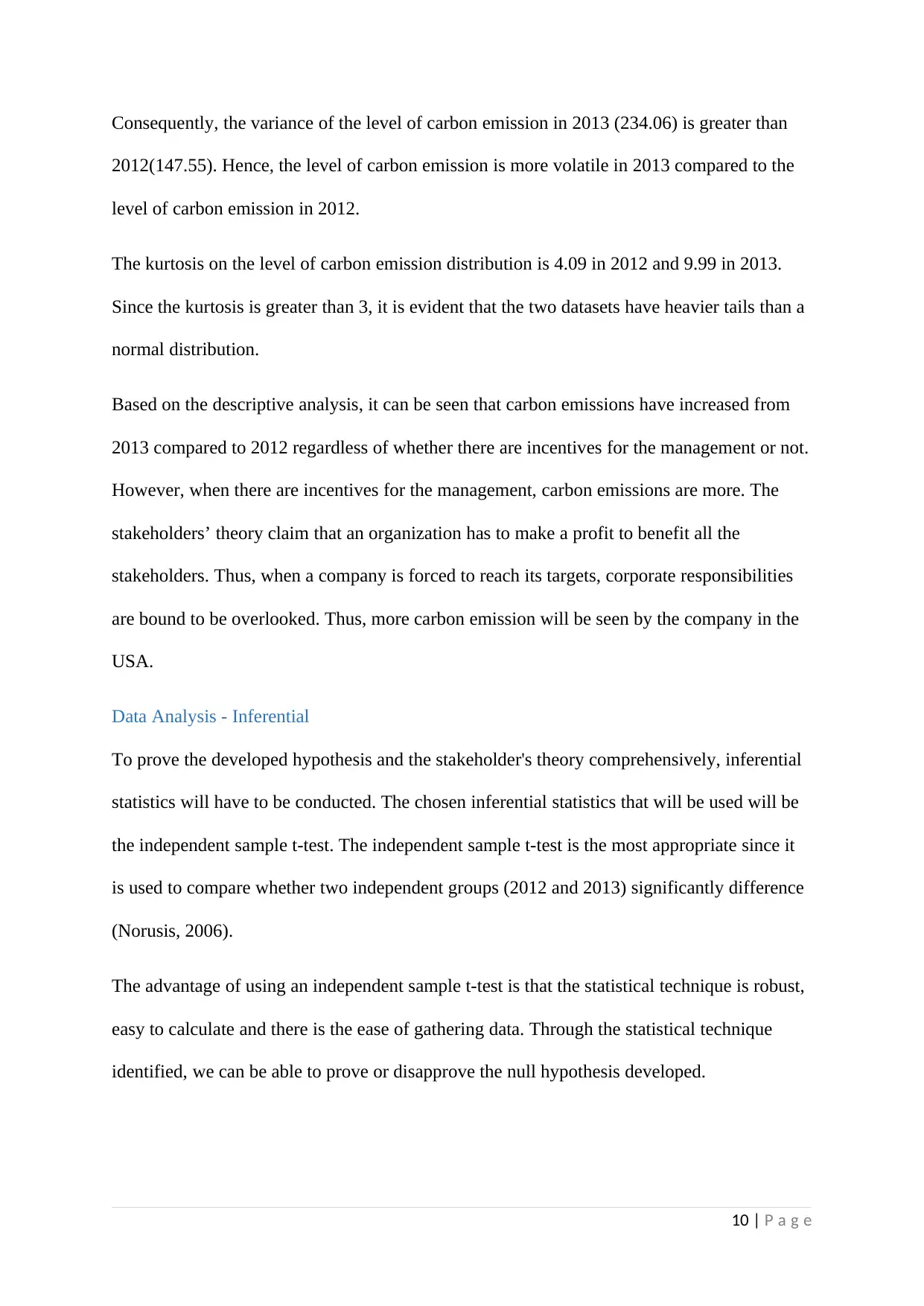
Consequently, the variance of the level of carbon emission in 2013 (234.06) is greater than
2012(147.55). Hence, the level of carbon emission is more volatile in 2013 compared to the
level of carbon emission in 2012.
The kurtosis on the level of carbon emission distribution is 4.09 in 2012 and 9.99 in 2013.
Since the kurtosis is greater than 3, it is evident that the two datasets have heavier tails than a
normal distribution.
Based on the descriptive analysis, it can be seen that carbon emissions have increased from
2013 compared to 2012 regardless of whether there are incentives for the management or not.
However, when there are incentives for the management, carbon emissions are more. The
stakeholders’ theory claim that an organization has to make a profit to benefit all the
stakeholders. Thus, when a company is forced to reach its targets, corporate responsibilities
are bound to be overlooked. Thus, more carbon emission will be seen by the company in the
USA.
Data Analysis - Inferential
To prove the developed hypothesis and the stakeholder's theory comprehensively, inferential
statistics will have to be conducted. The chosen inferential statistics that will be used will be
the independent sample t-test. The independent sample t-test is the most appropriate since it
is used to compare whether two independent groups (2012 and 2013) significantly difference
(Norusis, 2006).
The advantage of using an independent sample t-test is that the statistical technique is robust,
easy to calculate and there is the ease of gathering data. Through the statistical technique
identified, we can be able to prove or disapprove the null hypothesis developed.
10 | P a g e
2012(147.55). Hence, the level of carbon emission is more volatile in 2013 compared to the
level of carbon emission in 2012.
The kurtosis on the level of carbon emission distribution is 4.09 in 2012 and 9.99 in 2013.
Since the kurtosis is greater than 3, it is evident that the two datasets have heavier tails than a
normal distribution.
Based on the descriptive analysis, it can be seen that carbon emissions have increased from
2013 compared to 2012 regardless of whether there are incentives for the management or not.
However, when there are incentives for the management, carbon emissions are more. The
stakeholders’ theory claim that an organization has to make a profit to benefit all the
stakeholders. Thus, when a company is forced to reach its targets, corporate responsibilities
are bound to be overlooked. Thus, more carbon emission will be seen by the company in the
USA.
Data Analysis - Inferential
To prove the developed hypothesis and the stakeholder's theory comprehensively, inferential
statistics will have to be conducted. The chosen inferential statistics that will be used will be
the independent sample t-test. The independent sample t-test is the most appropriate since it
is used to compare whether two independent groups (2012 and 2013) significantly difference
(Norusis, 2006).
The advantage of using an independent sample t-test is that the statistical technique is robust,
easy to calculate and there is the ease of gathering data. Through the statistical technique
identified, we can be able to prove or disapprove the null hypothesis developed.
10 | P a g e
Secure Best Marks with AI Grader
Need help grading? Try our AI Grader for instant feedback on your assignments.
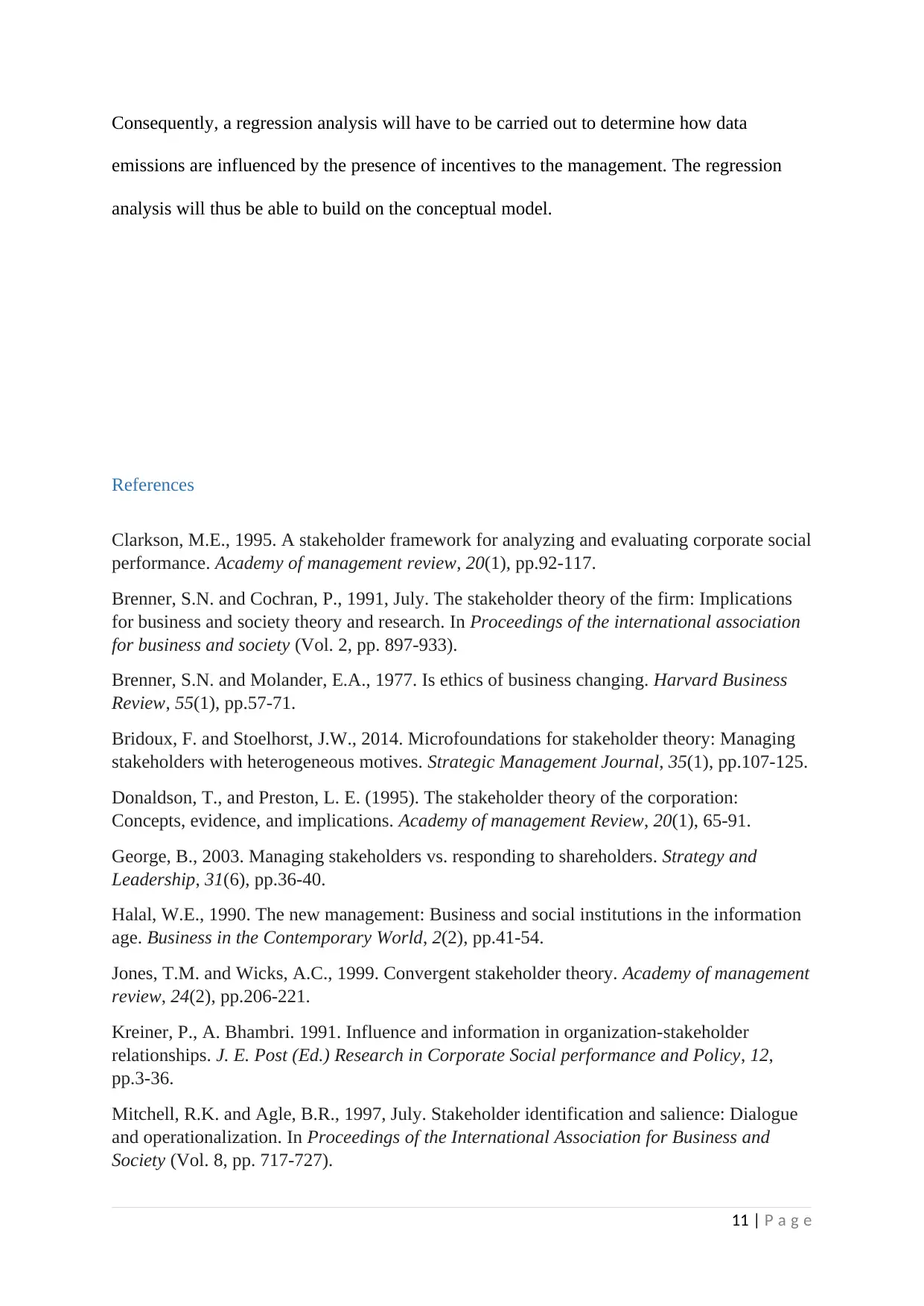
Consequently, a regression analysis will have to be carried out to determine how data
emissions are influenced by the presence of incentives to the management. The regression
analysis will thus be able to build on the conceptual model.
References
Clarkson, M.E., 1995. A stakeholder framework for analyzing and evaluating corporate social
performance. Academy of management review, 20(1), pp.92-117.
Brenner, S.N. and Cochran, P., 1991, July. The stakeholder theory of the firm: Implications
for business and society theory and research. In Proceedings of the international association
for business and society (Vol. 2, pp. 897-933).
Brenner, S.N. and Molander, E.A., 1977. Is ethics of business changing. Harvard Business
Review, 55(1), pp.57-71.
Bridoux, F. and Stoelhorst, J.W., 2014. Microfoundations for stakeholder theory: Managing
stakeholders with heterogeneous motives. Strategic Management Journal, 35(1), pp.107-125.
Donaldson, T., and Preston, L. E. (1995). The stakeholder theory of the corporation:
Concepts, evidence, and implications. Academy of management Review, 20(1), 65-91.
George, B., 2003. Managing stakeholders vs. responding to shareholders. Strategy and
Leadership, 31(6), pp.36-40.
Halal, W.E., 1990. The new management: Business and social institutions in the information
age. Business in the Contemporary World, 2(2), pp.41-54.
Jones, T.M. and Wicks, A.C., 1999. Convergent stakeholder theory. Academy of management
review, 24(2), pp.206-221.
Kreiner, P., A. Bhambri. 1991. Influence and information in organization-stakeholder
relationships. J. E. Post (Ed.) Research in Corporate Social performance and Policy, 12,
pp.3-36.
Mitchell, R.K. and Agle, B.R., 1997, July. Stakeholder identification and salience: Dialogue
and operationalization. In Proceedings of the International Association for Business and
Society (Vol. 8, pp. 717-727).
11 | P a g e
emissions are influenced by the presence of incentives to the management. The regression
analysis will thus be able to build on the conceptual model.
References
Clarkson, M.E., 1995. A stakeholder framework for analyzing and evaluating corporate social
performance. Academy of management review, 20(1), pp.92-117.
Brenner, S.N. and Cochran, P., 1991, July. The stakeholder theory of the firm: Implications
for business and society theory and research. In Proceedings of the international association
for business and society (Vol. 2, pp. 897-933).
Brenner, S.N. and Molander, E.A., 1977. Is ethics of business changing. Harvard Business
Review, 55(1), pp.57-71.
Bridoux, F. and Stoelhorst, J.W., 2014. Microfoundations for stakeholder theory: Managing
stakeholders with heterogeneous motives. Strategic Management Journal, 35(1), pp.107-125.
Donaldson, T., and Preston, L. E. (1995). The stakeholder theory of the corporation:
Concepts, evidence, and implications. Academy of management Review, 20(1), 65-91.
George, B., 2003. Managing stakeholders vs. responding to shareholders. Strategy and
Leadership, 31(6), pp.36-40.
Halal, W.E., 1990. The new management: Business and social institutions in the information
age. Business in the Contemporary World, 2(2), pp.41-54.
Jones, T.M. and Wicks, A.C., 1999. Convergent stakeholder theory. Academy of management
review, 24(2), pp.206-221.
Kreiner, P., A. Bhambri. 1991. Influence and information in organization-stakeholder
relationships. J. E. Post (Ed.) Research in Corporate Social performance and Policy, 12,
pp.3-36.
Mitchell, R.K. and Agle, B.R., 1997, July. Stakeholder identification and salience: Dialogue
and operationalization. In Proceedings of the International Association for Business and
Society (Vol. 8, pp. 717-727).
11 | P a g e
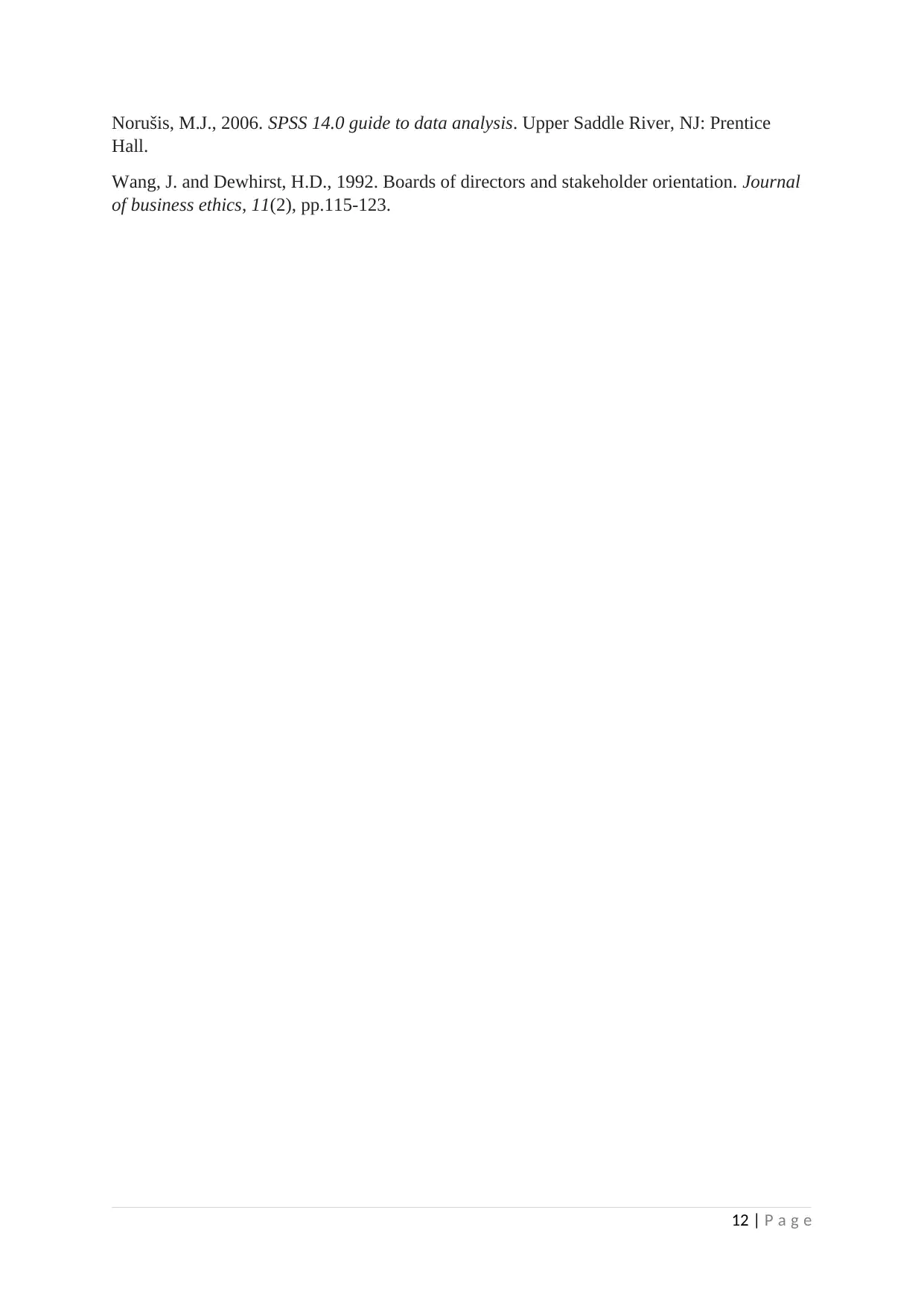
Norušis, M.J., 2006. SPSS 14.0 guide to data analysis. Upper Saddle River, NJ: Prentice
Hall.
Wang, J. and Dewhirst, H.D., 1992. Boards of directors and stakeholder orientation. Journal
of business ethics, 11(2), pp.115-123.
12 | P a g e
Hall.
Wang, J. and Dewhirst, H.D., 1992. Boards of directors and stakeholder orientation. Journal
of business ethics, 11(2), pp.115-123.
12 | P a g e
1 out of 12
Your All-in-One AI-Powered Toolkit for Academic Success.
+13062052269
info@desklib.com
Available 24*7 on WhatsApp / Email
![[object Object]](/_next/static/media/star-bottom.7253800d.svg)
Unlock your academic potential
© 2024 | Zucol Services PVT LTD | All rights reserved.





